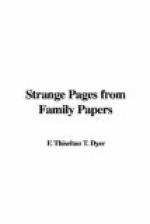In the year 1822, George iv. visited Scotland and searched out the families who had suffered by supporting the Princes of the Stuart line. Foremost of them all was the Erskine of Mar, grandson of Mar who had raised the Chevalier’s standard, and to him the King restored his earldom. John Francis, the grandson of the restored Earl, likewise came into favour, for when Queen Victoria accidentally met his Countess in a small room in Stirling Castle, and ascertained who she was, she detained her, and, after conversing with her, kissed her. Although the Countess had never been presented at St. James’s, yet, in a marvellous way, “the kiss of peace was given to her, though she sought it not”; and then, after the curse had worked through 300 years, the “weird dreed out, and the doom of Mar was ended."[2]
Another instance which may be quoted relates to Sherborne Castle. According to the traditionary accounts handed down, it appears that Osmund, one of William the Conqueror’s knights, who had been rewarded, among other possessions, with the castle and barony of Sherborne, in the decline of life determined to resign his temporal honours, and to devote himself exclusively to religion. In pursuance of this object, he obtained the Bishopric of Salisbury, to which he gave certain lands, but annexed to the gift the following conditional curse: “That whosoever should take those lands from the Bishopric, or diminish them in great or small, should be accursed, not only in this world, but in the world to come, unless in his lifetime he made restitution thereof.” In a strange and wonderful manner this curse is said to have been more than once fulfilled. Upon Osmund’s death, the castle and lands fell into the hands of the next bishop, Roger Niger, who was dispossessed of them by King Stephen, on whose death they were held by the Montagues, all of whom, it is affirmed, so long as they kept these lands, were subjected to grievous disasters, in so much that the male line became altogether extinct. About two hundred years from this time, the lands again reverted to the Church, but in the reign of Edward VI. the Castle of Sherborne was conveyed by the then Bishop of Sarum to the Duke of Somerset, who lost his head on Tower Hill. Sir Walter Raleigh, again, obtained the property from the crown, and it was to expiate this offence, it has been suggested, he ultimately lost his head. But in allusion to this reputed curse, Sir John Harrington gravely tells how it happened one day that Sir Walter riding post between Plymouth and the Court, “the castle being right in the way, he cast such an eye upon it as Ahab did upon Naboth’s vineyard, and whilst talking of the commodiousness of the place, and of the great strength of the seat, and how easily it might be got from the Bishopric, suddenly over and over came his horse, and his very face—which was then thought a very good one—ploughed up the earth where he fell.” Then again Prince Henry died shortly after he took possession,




